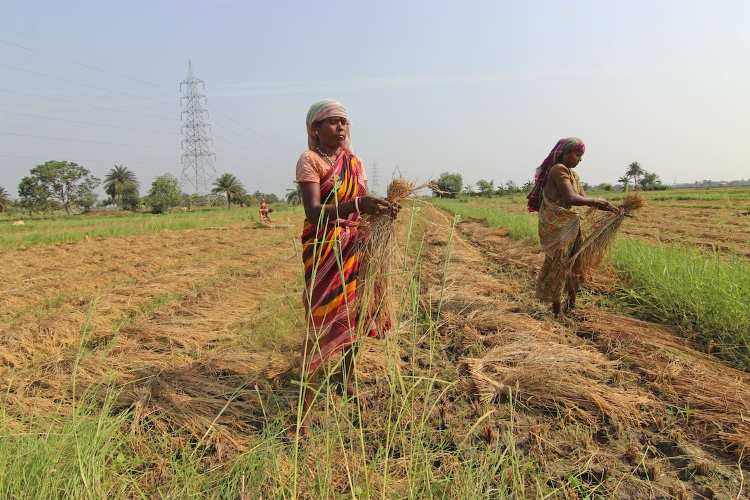
Need for land reforms and technology adoption: Agriculture has been the prime mover of the Indian economy for centuries, providing livelihoods to crores of people. However, the sector is currently grappling with several pressing issues that demand immediate reforms. India is the world’s second-largest producer of agricultural products, but its productivity levels are lower than those of many other countries. This is because of a number of factors, including small and fragmented landholdings, limited access to irrigation and other inputs, and inadequate technology adoption.
The sector is also vulnerable to climate change and other external shocks. In recent years, farmers have been grappling with droughts, floods, and other extreme weather events. These challenges have made it difficult for farmers to earn a sustainable income and have contributed to rural poverty and migration. This article will delve into three critical challenges facing Indian agriculture – land reforms, technology adoption, and tenancy policies.
READ I Choking on smoke: India needs innovative solutions to stubble burning menace
Land reforms and land leasing
One of the most significant challenges faced by Indian agriculture is the long-pending need for land reforms. The issue of land ownership and land titling has plagued the sector for decades. The ambiguity surrounding land titles has led to disputes, inhibiting farmers’ access to capital and credit. Land-related disputes account for nearly two-thirds of all pending court cases in India. These disputes take an average of 20 years to be resolved, causing financial strain on farming communities.
The absence of clear land titles hampers farmers’ ability to use their land as collateral for loans. This lack of access to institutional credit affects small and marginal farmers, who make up the majority of landholders in India. With more than half of the operational land area in their hands, these farmers are central to boosting agricultural output and ensuring food security.
To address this issue, India needs to shift from its presumptive land titling system to a conclusive one. A conclusive titling system, as seen in many developed countries, provides guaranteed titles, ensuring that once a person becomes a landowner, their ownership cannot be challenged in court. The government is responsible for compensating claimants in case of disputes. This change would significantly reduce legal battles, streamline land transactions, and unlock a vast amount of capital for agriculture.
Another critical aspect of land reform is the tenancy system. Post-independence, various states in India introduced tenancy reforms to regulate rent, provide security of tenure, and grant ownership rights to tenants. However, some of these reforms have had unintended consequences, hindering the consolidation of land holdings. For example, in Punjab and Haryana, where leasing land is common, small and marginal farmers are struggling to survive due to high costs of cultivation. Allowing longer-term leases of up to 10 years could bring benefits to both landlords and tenants, enabling more substantial investments and increasing productivity.
Embracing farm technology
Technology has played a pivotal role in transforming agriculture worldwide. The Green Revolution of the mid-20th century dramatically increased crop yields through the use of improved seeds, fertilizers, and irrigation. However, technology adoption in Indian agriculture is still evolving.
The modernisation of Indian agriculture requires a shift toward smaller, more affordable, and sustainable technologies. Instead of large tractors that are unsuitable for small landholdings, India should follow China’s example by investing in small-scale machinery that is appropriate for its predominantly small farms. These machines should be user-friendly, affordable, and accessible to small and marginal farmers.
Furthermore, technology can improve irrigation efficiency, conserve resources, and enhance productivity. Drip and sprinkler irrigation systems can save water and increase crop yields. Climate-smart agriculture practices, such as greenhouse farming and integrated pest management, can make farming more resilient and sustainable.
Indian agriculture is at a critical juncture, and the need for reforms is urgent. Clear land titles, flexible land leasing policies, and the adoption of appropriate agricultural technologies can revolutionise the sector. These reforms will empower small and marginal farmers, increase productivity, and ensure food security for India’s growing population.
The government’s role in facilitating these changes is crucial. Revisiting outdated land laws, investing in technology research and development, and promoting sustainable farming practices are essential steps. By tackling these challenges head-on, India can transform its agriculture sector into a modern, efficient, and sustainable powerhouse that meets the needs of the 21st century.
(Dr Parmod Kumar is the Director of Giri Institute of Development Studies, Lucknow. This article is the edited excerpt of a presentation made by Dr Kumar at a webinar organised by EGROW Foundation.)
